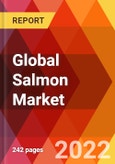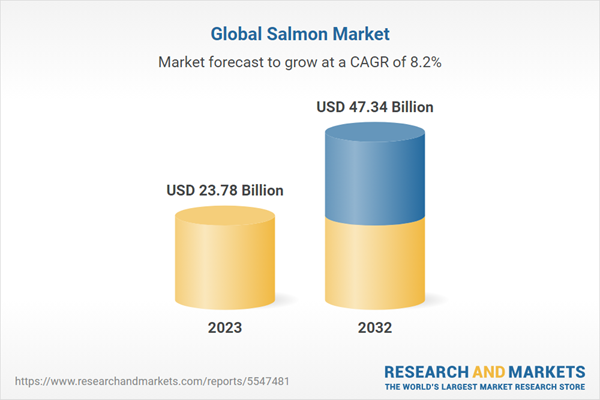The global salmon market has witnessed significant growth in recent years, driven by increasing demand for healthy and sustainable seafood. Salmon is highly regarded for its nutritional benefits, including being a rich source of omega-3 fatty acids, protein, and essential vitamins. The rising awareness of health and wellness, coupled with the growing popularity of diets rich in lean proteins, has boosted salmon consumption worldwide.Global Salmon Market Forecast till 2032: Set to Reach US$ 47.34 Billion by 2032 with a CAGR of 8.20%
Key market drivers include the expansion of aquaculture, advancements in fish farming technologies, and increasing consumer preference for fresh, organic, and responsibly sourced seafood. Europe and North America dominate the market due to established salmon farming industries, while the Asia-Pacific region is emerging as a lucrative market due to rising disposable incomes and changing dietary habits. Additionally, the growing trend of ready-to-eat and frozen seafood products has further fueled demand.
However, challenges such as environmental concerns related to overfishing, disease management in aquaculture, and fluctuating prices pose hurdles to market growth. Nonetheless, ongoing efforts to improve sustainable practices and meet regulatory requirements are expected to foster continued growth in the global salmon market. The market is poised to expand as consumers prioritize health-conscious and environmentally friendly food choices.
Growth Influencers:
The global salmon market has seen significant growth in recent years, primarily driven by increasing demand for healthy and sustainable seafood options. Renowned for its rich nutritional profile, salmon is a prime source of omega-3 fatty acids, high-quality protein, and essential vitamins. Rising consumer awareness of health and wellness, along with the popularity of lean protein diets, has led to a surge in salmon consumption worldwide. Key factors fueling this market expansion include the rapid growth of aquaculture, innovations in fish farming technology, and a strong consumer preference for fresh, organic, and sustainably sourced seafood. Europe and North America continue to dominate the market due to established salmon farming industries, while the Asia-Pacific region is emerging as a lucrative market, supported by rising disposable incomes and a shift toward healthier diets. However, the global salmon market also faces challenges, including environmental concerns over overfishing, disease management in aquaculture, and price volatility. Despite these obstacles, ongoing efforts to enhance sustainable farming practices and regulatory measures for environmental protection are expected to mitigate these issues. As consumers prioritize nutritious and responsibly sourced seafood, the market is well-positioned for continued growth.Segment Overview:
The Global Salmon market is categorized based on Species Type, Salmon Type, Product Type, End User and Distribution Channel.
By Species Type
- Sockeye Salmon
- Coho Salmon
- Pink Salmon
- Chum Salmon
- Atlantic Salmon
- Others
By Salmon Type
- Farmed Salmon
- Wild Salmon
By Product Type
- Fresh Salmon
- Frozen Salmon
- Canned Salmon
- Others
By End User
- Residential
- HoReCa
- Hotels
- Restaurants
- Café
By Distribution Channel
- Online
- Offline
- Supermarket/ Hypermarket
- Retail Stores
- Specialty Stores
The Farmed Salmon segment dominates the global market, holding a substantial share of 76.24% in 2023 and the highest CAGR of 8.53%. This growth is driven by the rising demand for sustainable seafood, with aquaculture providing a stable method to meet consumer needs. Leading salmon-producing countries like Norway, Chile, and Scotland employ advanced farming techniques to enhance production while reducing ecological impacts. Health awareness significantly contributes to the appeal of farmed salmon, known for its rich nutritional profile, particularly omega-3 fatty acids. Major retailers report strong sales growth in fresh farmed salmon products, which are increasingly popular due to their versatility in various culinary forms.
The Fresh Salmon segment leads the global market with a share of 59.28% in 2023, driven by growing consumer awareness of its health benefits, particularly its omega-3 content. Fresh salmon is often preferred for its superior taste and texture, making it a favorite in restaurants and among health-conscious consumers. Conversely, the Frozen Salmon segment is witnessing the highest CAGR of 9.71%, as busy households seek convenient meal options. The appeal of frozen salmon lies in its longer shelf life and ease of preparation, prompting retailers to expand frozen offerings. Technological advancements in freezing also help preserve freshness and nutritional value, particularly in the Asia-Pacific region, where demand for frozen salmon dishes, such as sashimi, is rising.
In the Global Salmon Market, the HoReCa (Hotels, Restaurants, and Catering) segment holds a substantial market share of 70.52% in 2023, with a leading CAGR of 8.62%. This growth is driven by increasing demand for salmon in premium dining establishments and catering services, with popular dishes including sushi and grilled salmon. The segment benefits from trends in health-conscious dining and salmon's versatility in upscale culinary applications. Meanwhile, the residential segment is also growing, with a CAGR of 7.14%, as more consumers opt for salmon in home cooking due to its nutritional benefits and ease of preparation. The availability of fresh and frozen salmon in supermarkets, alongside meal kits and delivery services, is facilitating this trend.
As of 2023, the offline segment dominates the global salmon market with a share of 61.08%, driven by traditional retail outlets like supermarkets and specialty seafood stores. Many consumers prefer buying salmon in-person to ensure freshness and quality, with major retailers like Walmart and Tesco leading sales. This segment's steady growth, at a CAGR of 7.52%, highlights ongoing demand for accessible seafood. In contrast, the online segment, while smaller, is experiencing rapid growth with a CAGR of 9.20%. E-commerce platforms are meeting consumer demand for convenience and home delivery, particularly post-COVID-19. Online channels offer detailed product information and a variety of salmon products, gaining popularity, especially in urban areas, while offline experiences continue to assure quality.
Regional Overview:
Based on Region, the market is divided into North America, Europe, Asia Pacific, Middle East, Africa and South America.- North America
- The U.S.
- Canada
- Mexico
- Europe
- Western Europe
- The UK
- Germany
- France
- Italy
- Spain
- Rest of Western Europe
- Eastern Europe
- Poland
- Russia
- Rest of Eastern Europe
- Asia Pacific
- China
- India
- Japan
- Australia & New Zealand
- South Korea
- ASEAN
- Rest of Asia Pacific
- Middle East
- Saudi Arabia
- Kuwait
- UAE
- Qatar
- Oman
- Bahrain
- Rest of Middle East
- Africa
- South Africa
- Egypt
- Nigeria
- Kenya
- Rest of Africa
- South America
- Argentina
- Brazil
- Rest of South America
Competitive Landscape:
The Global Salmon market is characterized by a vigorous competitive landscape, with prominent entities like players Mowi Spa, Salmar, Aquachile, Mitsubishi/Cermaq, Leroy Seafood, Grieg Seafood, Multiexport, Nova Sea, Salmones Blumar, and Bakkafrost among others at the forefront, collectively accounting for more than 60% of the overall market share. This competitive milieu is fueled by their intensive efforts in research and development as well as strategic partnerships and collaborations, underscoring their commitment to solidifying market presence and diversifying their offerings. The primary competitive factors include pricing, product caliber, and technological innovation. As the Global Salmon industry continues to expand, the competitive fervor among these key players is anticipated to intensify. The impetus for ongoing innovation and alignment with evolving customer preferences and stringent regulations is high. The industry's fluidity anticipates an uptick in novel innovations and strategic growth tactics from these leading corporations, which in turn propels the sector's comprehensive growth and transformation.Report Insights:
- The global Salmon market is projected to grow from US$ 23.78 billion in 2023 to US$ 47.34 billion by 2032, at a CAGR of 8.20%.
- Europe holds a 44.61% share of the global salmon market, driven by Norway and Scotland's high-quality Atlantic Salmon production.
- Rising consumer awareness of salmon's omega-3 content and health benefits, such as heart health and cognitive support, boosts global demand.
- The Asia-Pacific region has the fastest-growing salmon market, with rising disposable incomes and demand for sushi and sashimi.
- Europe's growth is fueled by sustainability initiatives, with certifications like ASC and MSC promoting eco-conscious choices.
Questions to be Answered:
- What is the estimated growth rate of the Global Salmon market?
- What are the key drivers and potential restraints?
- Which market segments are expected to witness significant growth?
- Who are the leading players in the market?
Table of Contents
Chapter 1. Research Framework
Chapter 2. Research Methodology
Chapter 4. Global Salmon Market Overview
Chapter 5. Global Salmon Market Analysis, By Species Type
Chapter 6. Global Salmon Market Analysis, By Salmon Type
Chapter 7. Global Salmon Market Analysis, By Product Type
Chapter 8. Global Salmon Market Analysis, By End User
Chapter 9. Global Salmon Market Analysis, By Distribution Channel
Chapter 10. Global Salmon Market Analysis, By Region
Chapter 11. North America Salmon Market Analysis
Chapter 12. Europe Salmon Market Analysis
Chapter 13. Asia Pacific Salmon Market Analysis
Chapter 14. Middle East Salmon Market Analysis
Chapter 15. Africa Salmon Market Analysis
Chapter 16. South America Salmon Market Analysis
Chapter 17. US Salmon Market Analysis
Chapter 18. UK Salmon Market Analysis
Chapter 19. France Salmon Market Analysis
Chapter 20. Germany Salmon Market Analysis
Chapter 21. Italy Salmon Market Analysis
Chapter 22. Spain Salmon Market Analysis
Chapter 23. China Salmon Market Analysis
Chapter 24. Japan Salmon Market Analysis
Chapter 25. UAE Salmon Market Analysis
Chapter 26. Company Profile
Companies Mentioned (Partial List)
A selection of companies mentioned in this report includes, but is not limited to:
- Grieg Seafood
- Lerøy Seafood Group ASA
- Mowi ASA
- Ocean Supreme AS
- SAFE CATCH
- SalMar ASA
- Sinkaberg Hansen AS
- Tassal Limited
- Wild Planet Foods
Table Information
| Report Attribute | Details |
|---|---|
| No. of Pages | 461 |
| Published | September 2024 |
| Forecast Period | 2023 - 2032 |
| Estimated Market Value ( USD | $ 23.78 Billion |
| Forecasted Market Value ( USD | $ 47.34 Billion |
| Compound Annual Growth Rate | 8.2% |
| Regions Covered | Global |









